Greetings and Salutations!
“May you live in interesting times!”
I’d have to say we got that going on in spades these days. Lots of info flying around about the Joetato deciding to ‘step back’ from the Re(s)election, so much so as to leave everyone wondering just how this happened when less than 24 hours go, the Pretender to the Glorious and Harmonious P&PBUH (Plus 10%) Orifice of The (p)Resident, The Dementor-in-Chief, Emperor Poopypants the First, Chief Executive of the Kidsmeller Pursuivant, Good Ole Slo Xi-Den was so absolutely adamant that he wasn’t going anywhere, anytime soon…
To paraphrase Captain Willard again: “The bullshit piled up so high in Vietnam Democrat Politics, you needed wings to stay above it!”
The best take I’ve seen on it?
Wow. <slow golf clap >
Now… besides the latest drama, my post for an Instructional that I think is going to be needed, leastways possibly? in the near future?
That being Range Cards and the “How to and Why” of them.
Now, a range card is, per the Manual: “A range card is a sketch of the assigned sector that a direct fire weapon system is intended to cover. A range card aids in planning and controlling fires and aids the crews and squad gunners in acquiring targets during limited visibility. It is also an aid for replacement personnel or platoons or squads to move into the position and orient on their sector. The individual soldier or gunner should make the range card so that he becomes more familiar with the terrain in his sector. He should continually assess the sector and, if necessary, update his range card. The range card is always being updated.”
The Range Card itself looks like this:
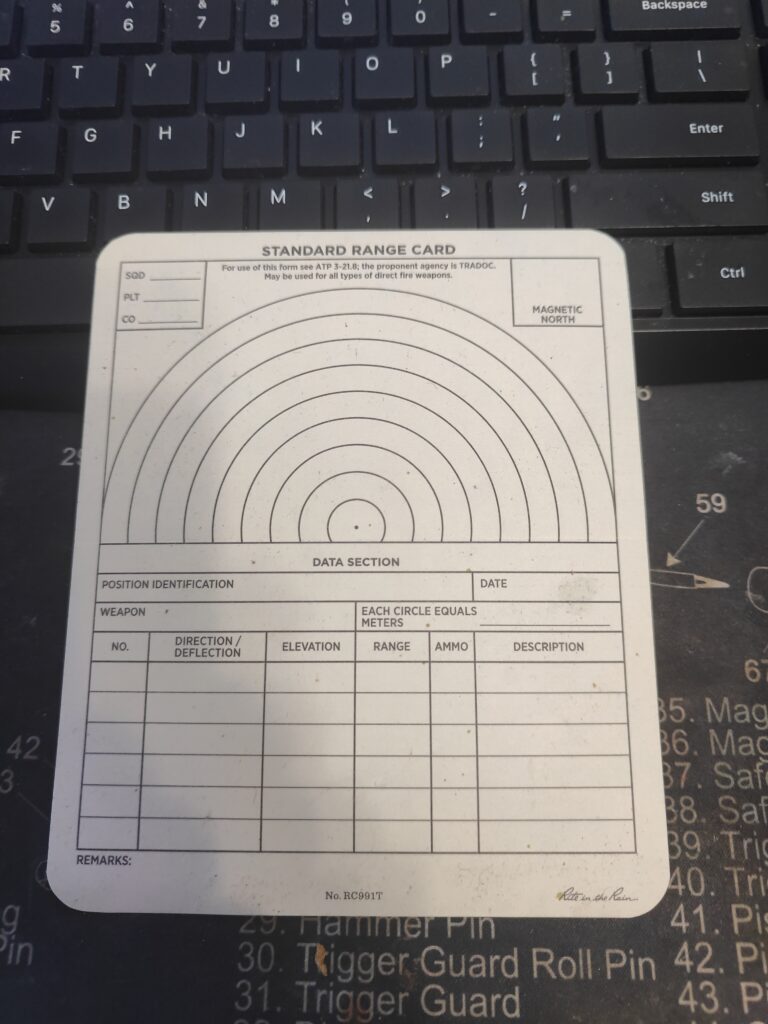
The actual DotMil Document number is a DA FORM 5517-R
FEB 1983. An .pdf (downloadable and printable) one can be found here: DA FORM 5517-R The ones I have are smaller, waterproof and meant to be folded and put into my wrist quick reference pouch.

Link HERE
The size of the card is really not that important. It’s primarily utilized to assist you, and others in being able to quickly identify various approaches, terrain features and dead space to your operational front.
The Purpose of the Range Card:
There are several goals that a Range Card seeks to achieve:
-aids in targeting known points during limited visibility
-identifies key terrain, sectors of fire, MELs, Enemy AA,
natural/man made obstacles, ‘Dead Space’
-allows several adjoining Range Cards to create a Sector
(Platoon Range Card)
-permits ANY replacing unit/Soldier to quickly conduct (RIP –
Relief In Place)
-uses a standard form for ease of use
-allows for precise targeting points (distance, direction, T&E
measurements etc.)
The preparation of the card incorporates ALL of the above information to provide a graphic (albeit crude) representation of the potential battlespace, to include approaches, and other key terrain features.
Everything ‘radiates’ from the dot in the center at the bottom of the card. Your Left and Right Limits (how far you can shoot/see/observe to your left and right OR the L&R Limit is where your particular positional responsibilities begin and end, as your Buddy t-FAT or Berglander in the foxhole/position next to you on the left takes over and starts HIS area of responsibility where your ends.
This means in this sort of instance, YOUR Left Limit Line would be your STOP, and Berglander’s RIGHT Limit Line is the START of his sector. A near complete card for example:
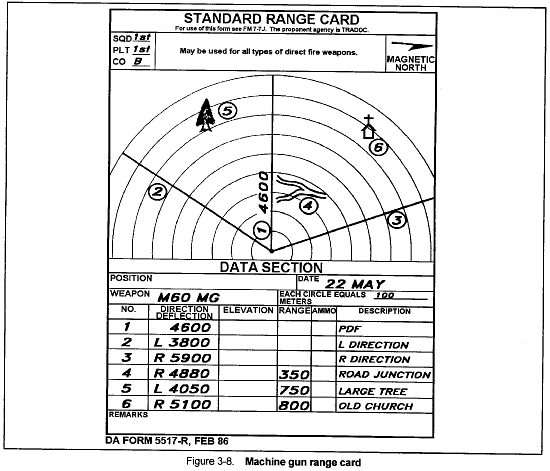
The lines also delineate the Sector(s) of Fire – The sector of fire is identified on the range card with a left and right sector limit drawn in. These lines represent the far left and far right areas the fire team or even just the ‘grunt in the hole’ is covering. If time permits, these sector lines should be accompanied with proper azimuths measured with a compass and then correctly annotated in the data section of the range card. These sector limits are important as they are used by commanders when setting up sector sketches, as well as by other coordinating elements.
The card information that you should put down if available is as such:
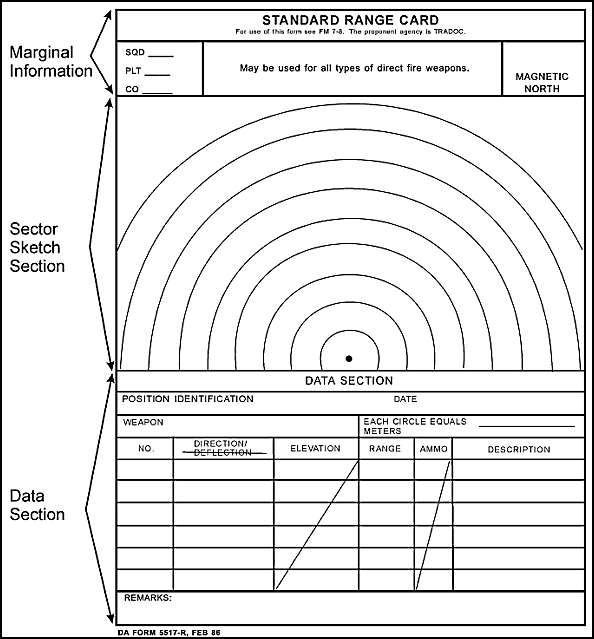
Marginal Info includes the who, as well as the map orientation in the upper right corner. It depends on how important that info is. Under the sort of circumstances that we may need it, positional defense fighting without heavy or even intermediate support, it comes down to personal preference. I’d say that it IS just good practice to do everything you can. As you might know ‘which way is North’ from your familiarity with the defensive position, however, a newbie might not.
The Data section – This refers to the bottom portion of the range card that provides an area for additional information such as weapon system, what distance each arc represents, TRP info and any other pertinent data for the team.
Now, per the manual, these are the steps ion order that one should utilize in preparing the card:

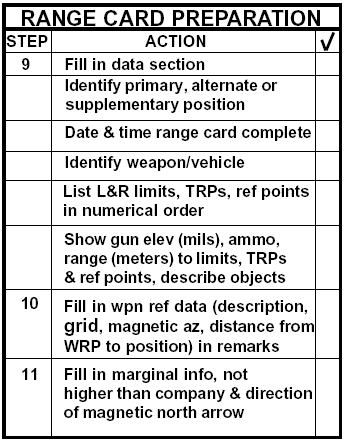
Each concentric line going around the card, those help determine range. You can guesstimate it, or if you want accuracy, and have the ability to genuinely measure it out it needs to be done.
An aside regarding ‘laser rangefinders’ and the hoopala about Lee Tardy Autist having one.
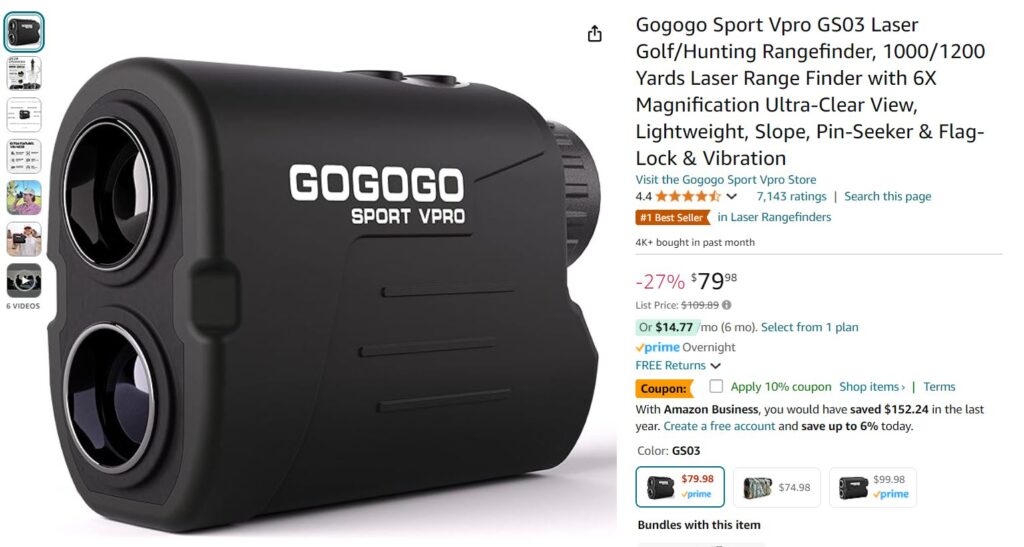
I bought one back in 2020 for less than the current rate. The link is HERE and yeah I get a taste. It was about $70? as I remember? but hey… for everyone of the morons out there yelling about “specialized DotMil Equipment” and the cost? They can go soak their heads… maybe the water will fill in some of that empty space between their ears…
Either way, a very handy tool to have.
The referenced “TRPs” stands for Target Reference Points – Target Reference Points (TRPs), are selected locations within a given sector that are identified on a range card with grid coordinates that can be pre assigned to artillery units in order to rapidly engage enemy units without having to go through all the normal steps when calling for fire. For sniper teams, TRPs are also used for various other reasons such as a spotter being able to use the TRP to direct his sniper onto a target as well as other uses. A team should have at LEAST one TRP on a range card, typically several would be better. Assigning the TRPs names helps with team communication and this can be done with standard SOP naming conventions, or simply calling it what it is, such as “road intersection”
Now, lets talk about “dead space”
Besides being a pretty good video game, it’s defined as “areas and masking terrain like depressions or ground behind hills/objects, such as buildings”
Using this as a card:

The roads, bridges, various woodlines and buildings have been drawn in. So far, so good. The next thing however is plotting your ‘blind spots/likely infiltration areas’ AKA ‘dead space’. This is identified on a range card by shading in the area(s) that are NOT within your immediate visual range:
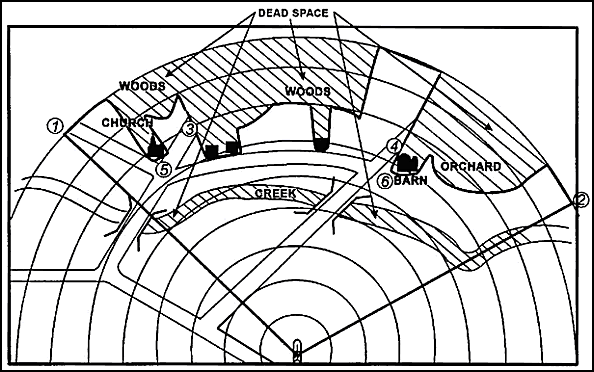
Terrian features like the creek, specifically depending on how deep/how high the walls of the banks are contribute to whether or not it would be considered an area of interest:

Now, IF you had higher support echelons, such as the ability to call for indirect fire, the dead space areas would be pre-registered for a call for fire. This means that if you have Bad Guys firing from the woodline, or behind the barn, you would, and could, via information on your range card, call for some pain to hit in the areas that have been defined.
In fact, this was part and parcel of the placement of the snipers at the event in Butler. The team of snipers, the one that EVERYONE has seen,
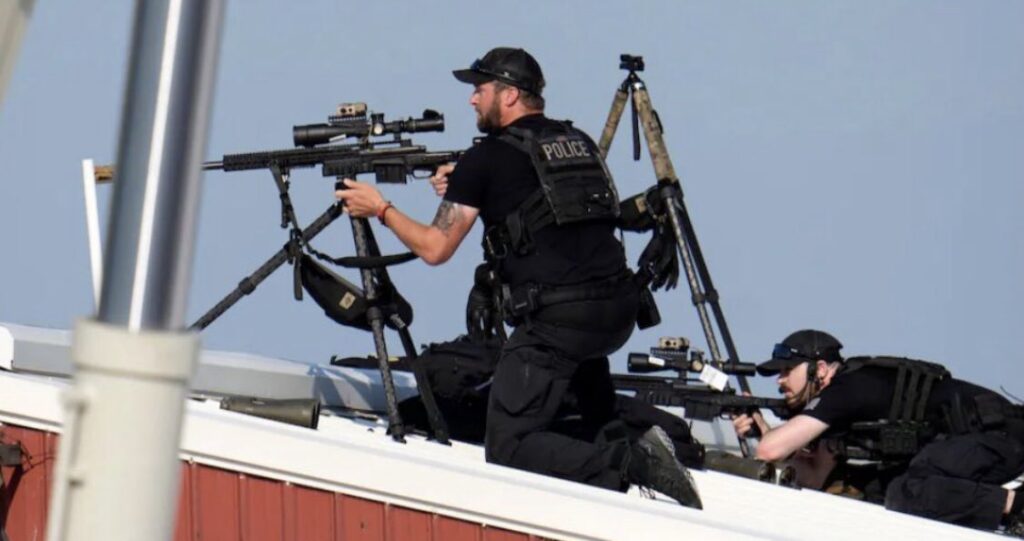
were placed in a position that blocked the direct line-of-sight to where the bad guy was set up. The MAJORITY of pictures are older ones that show the trees when they were still small-ish.
As they are NOW?
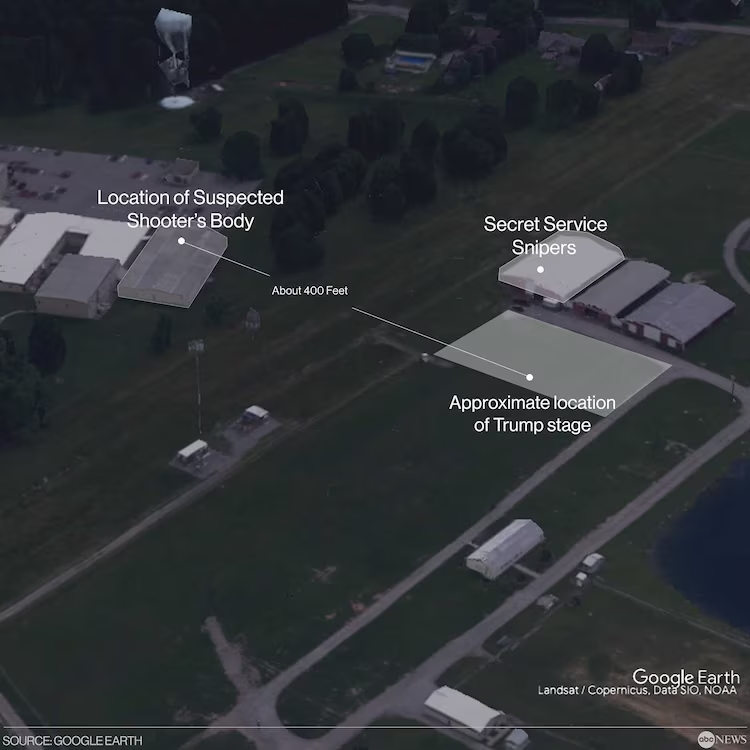
They’ve dialed down the illumination on the picture, but if you look closely there’s a lot of dead space that team could not cover. In fact it’s telling that the building that the team that did take out Lee Tardy isn’t even in the picture so to speak.
I’d say that gross incompetence played a role.
Maybe even a lack of proper range cards?
I know that range cards were mandatory in Sniper School. Guess that part of the curriculum is no longer part of it? That or:

Huh.
So I hope that gives you something to ‘play with’ and think about. It can be a lot of work in making them, but it is something that in a “Hard Times” situation, especially IF you have people/family members and other trusted elements that show up, but don’t know the area, it’s a critical item.
I have, for myself printed off some 8.5in x 11 Cards and laminated them, and have them for all four major corners/fronts of the house, with the ability to use good dry erase markers to keep them updated as needed. I also used some of the online wizardry to get the houses and various other semi-permanent structures printed, with the range card overlaid.
I say ‘semi-permanent’ in that in a full on Mad Max cycle, some of these houses might be reduced to burned out shells. One can never know, nor expect things to ‘remain the same’.
So hope this helps!
Let me know in the comments!
More Later
Big Country



Good info, thanks. When the internet is back working well i’ll pull satellite images of my area to make mine.
I printed up USGS maps of my immediate AO. Two sets and then laminated them. Amazing the detail your get in them.
Dopey DEI derelict democrats belong in the dead space where men tell no tales.
No room for commie and the CW II that they have planned with the Bolshevik maggot globalists won’t end well for them.
The Blue Helmets should show up nicely with no need for fancy gear.
After all, we shoot straight.
My only hope is that they come fully armed. The majority of the UN Blue-Bugmen have/use belt fed MG-3s as their SAW, the last iteration of the awesome German MG-42/44. I’d love to have one of them
The Danes had one out in Basrah. You get behind that gun for a “diemotherfuckerdie” 6-9 round burst and you’ve sent 25 rounds downrange.
I may have accidentally fired a 50-rd belt over the wall behind our range at the palace once…
Oops.
Also, Karl Dahl’s new book “Faction: With the Crusaders” is top notch. 9/10.
I second that.
That is a grail gun for me
Nothing would have happened, NOTHING!
For SWAT/LEO snipers, locations of your own troopies is also listed on the range card, and areas covered by roaming patrols. This helps identify ‘good guys’ so the sniper and spotter don’t freak out every time they see a guy with a gun.
Total failure by the on-scene commander (SS, of course) to make sure so many things didn’t go wrong.
Range estimation WITHOUT compromising/failing devices is a dying art. Part of my edc bag is a mildot monocle….but get caught with that by pro’s in a place they think you shouldn’t be and they will invite you in for a cup of tea and a chat. At least it doesn’t need batteries. Billy Dickson at 2nd Battle of Adobe Walls knocked an Boss Injun off his horse at over 1500 yards, during an O-group. There was no 3rd Battle of Adobe Walls, far as I remember. .50-90 Sharps, no glass.
Proper target indication to a colleague will save seconds, and perhaps lives (theirs and yours, for instance).
Let’s venture an opinion on Butler again, seeing as so few others are. Roofie was laying a trail, going about in unTrump clothing in a Maga crowd, and lasing Schutzstaffel and StWAT snipers, and whatnot. Look at meeee! Ah, who cares…
TBF, Billy Dixon always openly admitted that he was not aiming at any particular Indian. He just aimed the mass and got a good hit.
From what I recall, there were three bigwigs on horseback (admitted by them later) and he let fly at a venture….the guy he hit wasn’t kilt, but all three and their horses thought it was better to go somewhere else. Black powder is so nice because it is so predictable….and having a 500Ggr lump of lead arrive addressed “to whom it may concern” is the same as registered mail. There was another guy that sniped yankees off riverboats with a custom built large calibre BP muzzle loader….by the time anyone noticed a white puff in a thicket on a hillside at inconceivable range, some carpetbagger or unionista was on the deck leaking porridge, and in those pre-drone and shotspotter days, slim chance of ever catching him in the act. These days…..multiple concurrent distributed bangs, or whatever the available tech offers. This Butler crap…..amateurs, put together on the fly. If it were pro’s, or gifted amateurs, Don is dead. Or is Don surviving also part of the plan. We helots are screwed either way. But, technicians must ever be learning…
I have an 1873 Springfield Trapdoor and an 1884. Haven’t shot either one yet, but looking forward to getting some cowboy loads and having at it!
Lecture & Lab:
https://raconteurreport.blogspot.com/2024/07/range-cards.html
Love your range care dealy! They’re so so many range cards available. As an ex Popo shooter we drifted towards “ Rifles Only” out of Texas. Been 14 years since! Don’t know if they’re still in business.
A reminder precision shooting is such a perishable skills set, if your on your A game your shooting at least weekly unit more.
Make sure whatever you gots modified to meet your needs.
A lot of individualism in being a sniper, you pick the spot, you route the stalk, you determine the hide construction. Or zero-hide, if not applicable.
A lot of satisfaction in hitting targets at distance, without that confidence of ranging, dialing your dope correctly, inputting that dope into your scope. And the disipline to remain immobile in all kinds of shitty weather until it’s time.
Big, these lessons are critical to our people!
Nicely done,
Dirk
Great poast’, per usual. Always enjoy reading a fellow Screaming Eagle’s take on stuff and things.
Curious to the performance of that laser range finder. Im in need of a replacement, and uncle suger isent paying my ammo and equipment bill anymore.